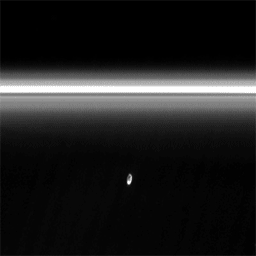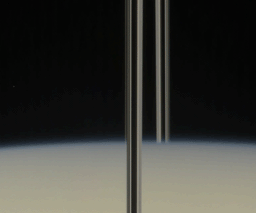Emily Lakdawalla • Oct 31, 2007
Cool Cassini animations
There have been some tremendous sets of images posted to the Cassini raw images website lately, and Gordan Ugarkovic has stepped in to animate them.
This first one absolutely took my breath away. It is an animation consisting of 254 different frames on one edge of Saturn's rings (3.4 MB, Quicktime .mov format). Gordan has posted it at 12 frames per second, and even at that rate it runs 21 seconds long. As you watch, you see seven of Saturn's moons spin around the ring ansa. Watch it again and you'll notice the little waves excited in the ring edges by the passage of these moons, and you'll see the braiding of the F ring. Watch it again and you'll observe that some rings are more eccentric than others. I'm sorry I can't post a preview, but it would be impossible to make one with a small enough file size that would do the sequence justice. To all of you who ever give talks, formal or informal, on space exploration, download this movie and show it off. It does an amazing job of capturing the dynamism of Saturn's ring system.
The first three moons that pop into view, almost at the same time, are Pandora (outside the skinny F ring), Prometheus (inside the F ring), and Atlas (outside the A ring). If I'm not mistaken, I think that maybe Daphnis is also running in the same pack in its tiny gap, the Keeler gap, at the outermost edge of the A ring. As Prometheus passes by you can see the gores left behind in the F ring by its periodic "collision" with the ring. Janus pops into view next. After that one disappears, you can start to see a bunch of brighter ringlets in the largest visible gap in the image, which is the Encke gap, home to Pan. After Janus reappears, Pan pops into view in the gap, right behind a double ringlet. Right at the end, Epimetheus hoves into view at the upper edge. After you've had fun watching the moons a few times, ignore the moons and watch all the wave action and eccentricity in the rings. It's absolutely mesmerizing.
I just realized that I forgot to post this amazing animation of Prometheus making one of those gores; this one was released by the imaging team a few weeks ago on the occasion of Cassini's 10th anniversary in space.

NASA / JPL / SSI
Prometheus' interaction with the F ring
This movie sequence represents almost one complete orbit of Saturn by Prometheus, the inner shepherd of the F ring. Both the F ring and Prometheus have slightly elliptical orbits, so, once each orbit, Prometheus wanders in to the dusty lanes of the F ring. As it moves back toward Saturn, Prometheus drags a streamer of dusty material behind it. Because Prometheus is closer to Saturn than the F ring, it orbits slightly faster, so the streamer lags behind Prometheus in its orbit. On the next pass around Saturn, Prometheus will intersect the F ring at a position 3.2 degrees of longitude ahead of this streamer, creating a new streamer. Over time, the streamers disappear. Cassini has seen as many as 15 streamers behind Prometheus in its orbit.The 72 images for this animation were taken 10.5 minutes apart over November 23 and 24, 2006. They have been reprojected to straighten out the F ring, showing the actual radial distance between Prometheus and the ring. The dark frames represent the period during which Prometheus and the F ring are eclipsed by Saturn's shadow. The movie is also available in Quicktime format (2 MB).

NASA / JPL / SSI / Gordan Ugarkovic
Mimas 'rising' from behind Saturn
In this 10-frame animation captured on October 26, 2007 beginning at about 17:47 UTC, Mimas appears to "rise" from behind Saturn's limb. The animation consisted of clear-filter images; they have been colorized based on one full-color set taken at the end of the sequence. Saturn and Mimas are at extremely low phase -- the Sun is almost directly behind Cassini -- so little of Mimas' rugged topography is visible. However, there is a noticeable flat spot on Mimas' western (upper) limb, which is the rim of the giant crater Herschel. The movie also illustrates how Mimas, unusually among Saturn's inner moons, has an inclined orbit. Cassini is on the north (right), unilluminated side of Saturn's ring plane. Moons that orbit outside the rings exactly in the ring plane would appear on the left side of the rings if they were closer to Cassini than Saturn, and on the right side of the rings if they were farther from Cassini than Ssaturn. The fact that Mimas is on the left side of the rings yet is evidently behind Saturn tells you that its orbit must be tilted with respect to the ring plane.I'll also mention that I have finally received an updated version of the tour table encompassing the entire extended mission. It's going to take me a little while to process it and update that page, but I'll get it out soon. Before I embark on that project, if anybody has any suggestions for improvements to that page, now would be the time to make them...I think I'm going to add an entry for orbit inclination and phase to the Saturn periapsis and apoapsis entries, as that tells you a lot about what Cassini will be seeing on each orbit.
The Time is Now.
As a Planetary Defender, you’re part of our mission to decrease the risk of Earth being hit by an asteroid or comet.
Donate Today

 Explore Worlds
Explore Worlds Find Life
Find Life Defend Earth
Defend Earth

